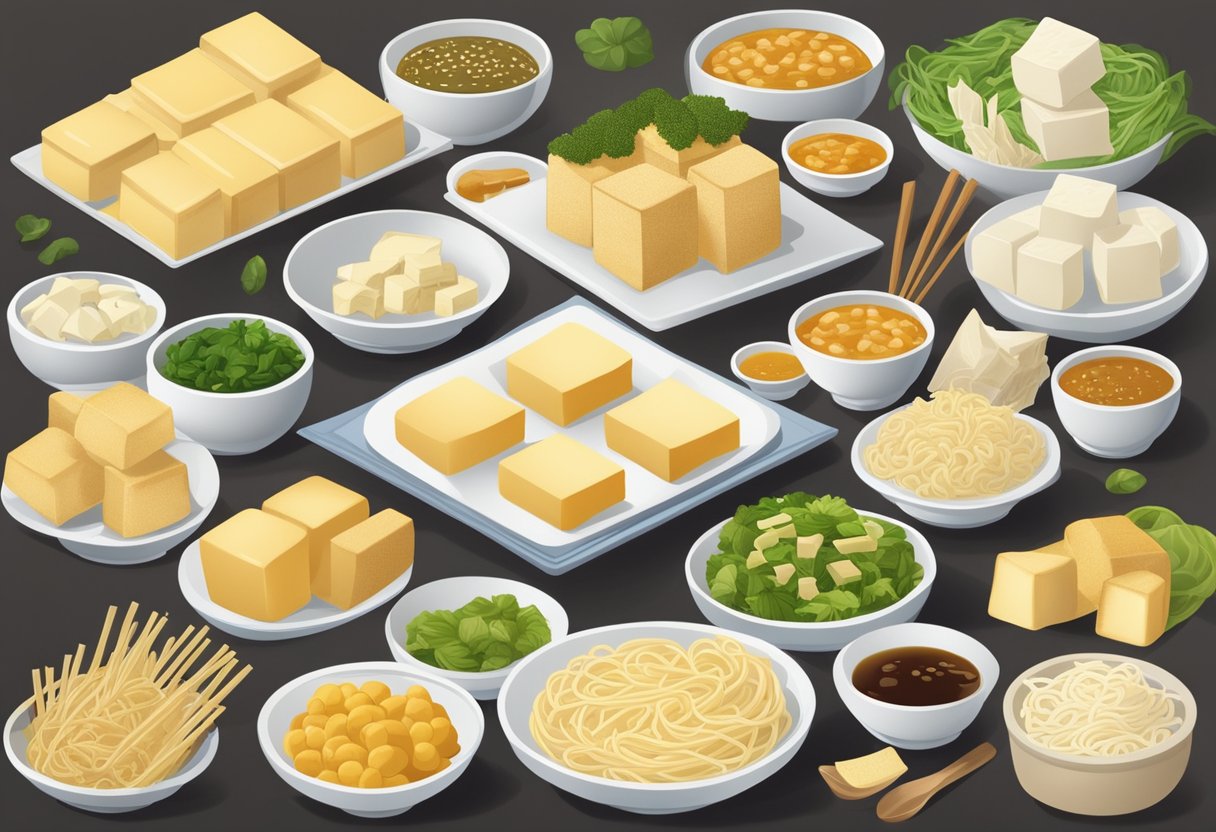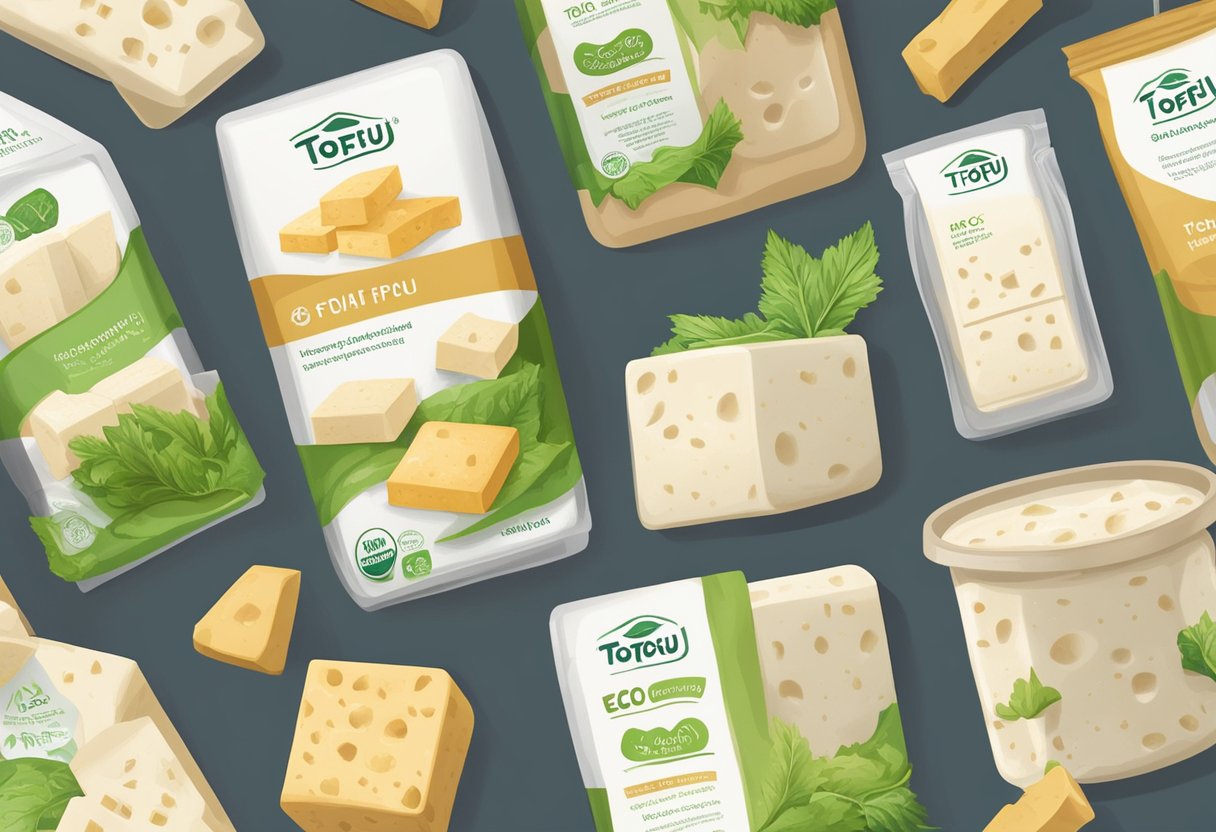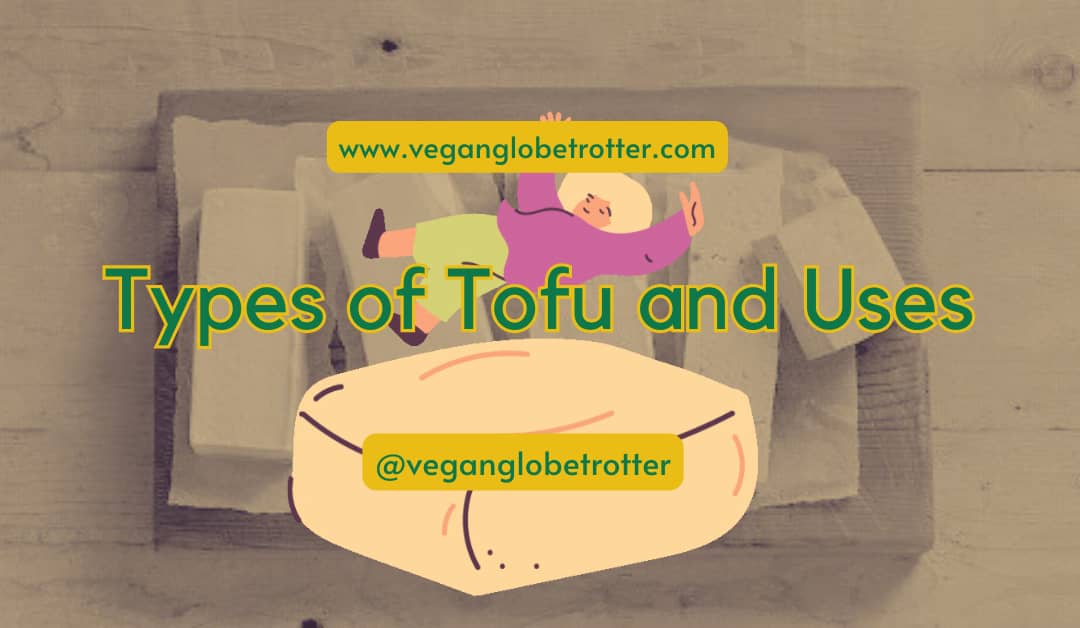Vegan Globetrotter is supported by our audience. When you purchase through one of our links, we may earn a small affiliate commission. As an Amazon Associate I earn from qualifying purchases. Your cost is not affected.
==================
Tofu is a versatile ingredient hailed for its adaptive qualities in various culinary applications. Originating from China over 2000 years ago, it has become a global staple in vegetarian, vegan, and meat-based diets. Different types of tofu have unique textures and flavors suitable for different recipes.
Types of Tofu and Uses: An Essential Guide to Tofu Varieties and Culinary Applications

Made from coagulated soy milk that is then pressed into solid white blocks, tofu comes in a range of textures, from silken to extra-firm, each suited for different dishes. Silken tofu’s delicate structure is ideal for smoothies and desserts, while firmer varieties hold up well in stir-fries and grilling.

Understanding the tofu types is crucial for culinary success and nutritional optimization. Selecting the appropriate type can transform a dish, with firmer types often being marinated and baked for a hearty addition to meals.
Softer tofus are commonly used to enrich sauces and soups. Beyond its flexibility in cooking, tofu is celebrated for its health benefits, offering a substantial source of protein, amino acids, and minerals such as calcium and iron—all while being low in calories and containing no cholesterol.
Key Takeaways
- Tofu is an adaptable soy product with varieties ranging from silken to extra-firm.
- The selection of tofu type can significantly influence the dish’s texture and flavor.
- Tofu’s nutritional profile makes it a beneficial addition to a variety of diets.
Tofu Fundamentals
Video Credit: @marystestkitchen
Tofu is a versatile soy-based product that comes in various textures, each suitable for different culinary applications. Understanding the key characteristics of each type allows for optimal use in recipes.
Silken Tofu
Silken tofu has a creamy, custard-like texture, making it perfect for smoothies, creamy sauces, and desserts. It’s a delicate form of tofu that blends well due to its high water content.
Firm Tofu
Firm tofu is denser than silken tofu, holding its shape well, which allows it to be used in a broader range of cooking methods. It also works well in stir-fries and grilling, which is ideal for mashing to recreate cheese textures or egg-based dishes.
Extra-Firm Tofu
Extra-firm tofu is the most dense and solid version, known for its low moisture content. This type excels in recipes where it needs to retain its shape under high heat or pressure, such as when pan-frying or when acting as a meat substitute in burgers and kebabs.
Tofu Preparation Techniques
Video Credit: @CheapLazyVegan
Proper tofu preparation can significantly enhance the flavor and texture of dishes. These techniques cater to different types of tofu and cooking methods.
Pressing Tofu
Pressing tofu is essential for removing excess moisture, especially when working with non-silken varieties. The process involves wrapping the block of tofu in a clean kitchen towel or paper towel and placing a heavy object on top, such as a cookbook or a skillet, for about 15-30 minutes. Firmer textures are typically achieved through longer pressing times.
Marinating Tofu
Tofu acts as a sponge, absorbing flavors from marinades. Creating a marinade with ingredients such as soy sauce, vinegar, or sesame oil can impart depth to tofu. For effective marinating, tofu should be cut into desired shapes and sizes and then soaked in the marinade for at least 30 minutes or overnight for maximum flavor infusion.
Baking Tofu
Baking tofu is a straightforward way to achieve a chewy and firm texture. Before baking, tofu should be pressed and possibly marinated. It is then cut into cubes or slices and baked in an oven at approximately 350-400°F until the edges are golden and crispy, which typically takes about 20-30 minutes.
Frying Tofu
Frying tofu can be done in two ways: pan-frying or deep-frying. Pan-frying involves cooking tofu in a small amount of oil over medium heat until all sides are crisp and golden.
For deep-frying, tofu should be submerged in hot oil at 350-375°F until it turns golden brown, which usually takes a few minutes. Always ensure tofu is well-pressed prior to frying to avoid oil splatter.
Culinary Uses of Tofu
Video Credit: @mohammedbarazi587
Tofu is celebrated for its versatility and protein content, making it a staple in diverse culinary applications. It adapts well to various flavors and cooking methods, serving as a key ingredient in traditional and contemporary dishes.
Tofu in Vegan Cooking
Tofu is a fundamental component in vegan cuisine due to its high protein content and ability to absorb flavors. Silken tofu is often blended into smooth, creamy bases for vegan desserts and sauces, while firm and extra-firm varieties are typically pressed, marinated, and then baked or fried to create a satisfying, chewy texture that can be added to salads, stir-fries, and more.
Tofu in Asian Cuisine
Tofu’s roots in Asian cuisine are deep and varied. It’s frequently incorporated into soups, like the classic miso soup, where silken tofu is valued for its soft texture.
Firm tofu is a cornerstone in dishes such as mapo tofu for its ability to maintain shape and texture when stir-fried with intense spices and sauces. Preparations include steaming, pan-frying, or deep-frying, often served with soy sauce and spices.
Tofu as a Meat Substitute
Tofu’s ability to stand in for meat is well-regarded in vegetarian and vegan diets. It’s used in an array of recipes ranging from tofu scrambles mirroring scrambled eggs to mimicry of meat textures in dishes like vegetarian chili. The high-protein content and adaptable nature of extra-firm tofu make it especially suitable for grilling and sautéing in savory creations.
Health and Nutrition
Video Credit: @Webmedy
In assessing tofu’s health benefits, it’s vital to consider its high-quality protein content and bounty of vitamins and minerals.
Protein Content in Tofu
Tofu is an excellent source of complete protein, providing all nine essential amino acids that the body cannot synthesize on its own. Specifically, a 3.5-ounce serving contains about 8 grams of protein, which is crucial for muscle repair, immune function, and overall bodily maintenance.
Tofu’s Vitamins and Minerals
Tofu is not just protein-rich. It is also laden with a variety of vitamins and minerals. This includes:
- Calcium: Essential for bone health and muscular function.
- Iron: Critical for oxygen transport in the blood.
- Magnesium: Key for metabolic reactions and maintaining nerve and muscle function.
- Phosphorus: Important for bone strength and tissue maintenance.
Additionally, tofu provides smaller amounts of potassium, zinc, and B vitamins, making it a valuable addition to a balanced diet.
Tofu Variations and Derivatives

Tofu presents a versatile landscape of tastes and textures, ranging from seasoned versions ready to eat out of the package to fermented types with unique flavors and the indispensable tofu skin used in various culinary creations.
Seasoned Tofu
Seasoned tofu comes pre-flavored with spices, herbs, or marinades and offers a ready-to-eat protein option for quick meals. Examples include lemon pepper tofu or smoked tofu, the latter being appreciated for its deep, robust flavor and compatibility with dishes like smoked tofu goulash.
Fermented Tofu Products
Fermented tofu, also known as fuyu or doufu-ru, showcases a pungent and savory profile. Typically immersed in brines with rice wine, chilies, and other seasonings, these products are staples in dressing dishes such as congee or stir-fries, introducing a burst of umami.
Tofu Skin
Tofu skin, or yuba, forms as a thin layer during the tofu-making process when soy milk is heated. It is revered for its delicate, slightly chewy texture and is utilized in myriad ways – from fresh in salads to dried as a meat substitute in entrees.
Storing and Shelf Life of Tofu
Video Credit: @BlenderKitchen
When it comes to storing tofu, the key is to keep it moist and cool. Unopened tofu can remain in its original packaging until the expiration date. Once opened, it should be kept in the refrigerator in an airtight container, submerged in water. The water should be changed daily to maintain freshness.
| State | Storage Method | Shelf Life |
|---|---|---|
| Unopened | In original packaging, refrigerated | See package date |
| Opened, unused | In water, in airtight container, fridge | 3-5 days |
| Opened, used | In water, changed daily, fridge | Up to 5 days |
| Frozen | In airtight container or freezer bag | 1-2 months |
Freezing tofu is an alternative method that extends its shelf life and alters its texture, making it more porous and chewy. Drain and pat the tofu dry before freezing. When frozen, it can last for one to two months. Thawing should be done in the refrigerator overnight or by using a microwave.
It is important to check for spoilage regularly. Spoiled tofu may exhibit a sour smell, a change in color, or a slimy texture. If any of these signs are present, don’t eat the tofu.
The correct storage of tofu will not only prolong its shelf life but also ensure that its texture and flavor are preserved, making it a versatile ingredient suitable for a variety of cooking applications.
Ethical and Environmental Considerations

When considering tofu as a food choice, it is important to acknowledge the ethical and environmental implications. Tofu production is generally environmentally friendly compared to meat, mainly because it has a lower carbon footprint, uses less water, and requires less land. Specifically, producing tofu results in significantly lower carbon emissions than beef, as noted by Consumer Ecology.
However, the environmental impact of tofu can vary based on several factors:
- Source of soybeans: It’s important to ensure that the soy used for tofu is not contributing to deforestation. Some soy sources are from deforested lands in Brazil.
- Agricultural practices: Organic soybeans tend to have a lower impact on the environment compared to conventionally farmed ones.
The ethical considerations associated with tofu production are complex. Purchasing tofu that adheres to certified organic standards can help minimize the environmental impact. Ethically-minded consumers might want to avoid products from areas involved in deforestation, such as certain parts of Brazil, a concern highlighted by Sustained Kitchen.
Here’s a breakdown of key points:
| Consideration | Ethical Impact | Environmental Impact |
|---|---|---|
| Carbon Footprint | Low | Much lower than meat |
| Land Use | Requires less land than livestock | Reduces pressure on ecosystems |
| Water Use | Generally less water-intensive | Contributes to conservation of water resources |
| Agricultural Practices | Organic farming is preferable | Less pesticides and herbicides needed |
Individuals can make ethically and environmentally sound decisions by being mindful of the origin and methods used to produce tofu.
Wrapping It Up
Tofu comes in various types, each with unique uses. Silken tofu is great for smoothies, and firm tofu is great for stir-fries. Explore different textures for different dishes.
Tofu absorbs flavors well, making it versatile. Remember, it’s a healthy protein source. Enjoy experimenting with tofu in your cooking!
Frequently Asked Questions
What distinguishes silken tofu from soft tofu?
Silken tofu has a creamy, custard-like texture and is undrained, unpressed soy milk that has been coagulated directly in its packaging. In contrast, soft tofu is slightly firmer than silken, drained, and pressed to some extent.
Can you share some firm silken tofu recipes?
Firm silken tofu is excellent in dishes requiring a delicate yet defined structure, such as miso soups, smoothies, or lightly pan-seared with a soy sauce glaze.
What are the different varieties of tofu available?
The different types of tofu include silken, soft, firm, extra-firm, and seasoned varieties like smoked tofu and tofu puffs, each suitable for various culinary applications.
Which variety of tofu is the healthiest option?
All tofu varieties share health benefits due to their high protein and low fat content. However, sprouted and organic tofus are the healthiest options due to their improved digestibility and absence of additives.
What are some techniques for frying tofu to enhance its texture and flavor?
Frying tofu can involve coating it in cornstarch or a marinade before cooking to achieve a crispy exterior. Pressing tofu to remove excess water before cooking can also significantly enhance both its texture and flavor absorption.
Where is the most appropriate place to purchase silken tofu?
Silken tofu can be commonly found in Asian supermarkets, health food stores, or any well-stocked grocery store in the refrigerated section alongside other tofu varieties.
Learn Vegan Cooking With Us!
Discover the various vegan dishes with Vegan Globetrotter. Learn aromatic and appetizing vegan dishes that blend flavor, health, and simplicity. Stay connected and enhance your vegan cooking skills:
- Facebook: Vegan Globetrotter
- Instagram: @_veganglobetrotter
- Pinterest: The Vegan Globetrotter
- Twitter: @VeganGlobetrot
Join our community and explore the wonders of vegan cooking! For more insights into the world of vegan cooking, visit our website: veganglobetrotter.com









Don't miss out
when new recipes and information are added!
Join our newsletter for free recipes,
healthy living inspiration, and special offers
You have Successfully Subscribed!